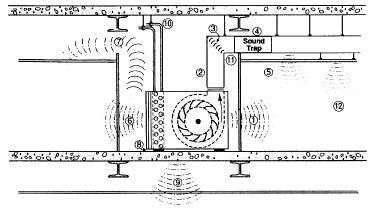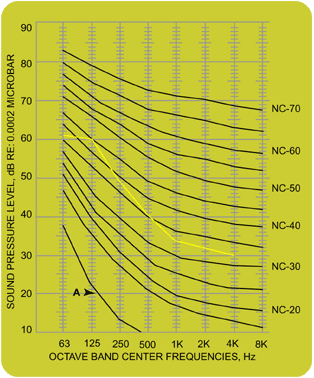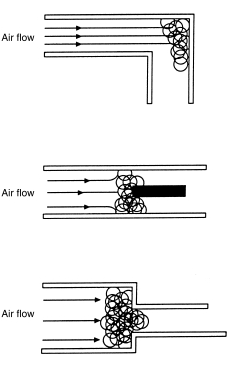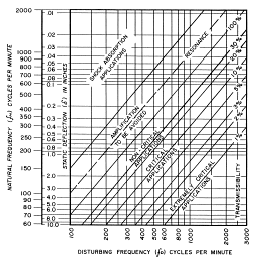




HVAC Applications The Challenge Building design and construction must include engineering controls for HVAC equipment to limit objectionable noise and vibration levels. Meeting the acoustical expectations of building owners and occupants has become increasingly difficult with today's lightweight construction methods and with HVAC systems that are located in close proximity to occupied spaces and listener critical environments. BProper design and effective use of noise and vibration control materials are required to avoid system problems. QWYATT has the practical experience using proven and tested materials to quiet mechanical systems in new design and remedial construction projects. There is no cost or obligation to consult with us on your next project. HVAC System Problems Noise and vibration problems in HVAC applications are rarely caused solely by the ventilation equipment. Most such complaints are system problems relating to the lack of integration of all system components. Improper selection, design or installation can result in system problems despite the use of duct silencers, sound absorptive duct liners and other common noise and vibration treatments.
Correction Vs. Prevention Correcting a noise or vibration problem after start-up of the HVAC system costs much more than addressing the potential problems at the design stage. Short cuts to save on construction costs may result in real costs far exceeding the monetary cost in direct payments to the retrofitting contractors. The opportunity costs of time lost in the investigation, analysis and implementation of a solution and the loss of goodwill from the building owner and/or tenants are also part of the real costs. The cost of prevention to incorporate sufficient noise controls and integrate all of the system components into a quiet design has been estimated at as little as 1% of total HVAC system costs. The benefits of prevention more than justify this small incremental increase in project costs.  Typical "System" Problems For A Common Air Handling Application Are Shown Above And Described In More Detail Below
Acoustical Rating Systems And Criteria
Noise Criteria (NC) Curves Standardized NC curves are plotted at left along with frequency spectrum data for a particular room application. The NC-45 rating for the example, at left, is determined by comparing the plotted data to the standardized curves and finding the highest penetration which in this case is the tangent point on the NC-45 curve at 125 Hz (60 dB). The A curve represents the approximate threshold of hearing for continuous noise. The NC rating system should be used with caution in evaluating environments with dominant low frequency levels as the standardized curves do not extend down into the 16 Hz and 31.5 Hz octave bands. Another caution/limitation of this system is the inability to differentiate the subjective quality of the noise for equivalent rating values. Recommended NC Levels For Various Activities
Detailed procedures for calculating HVAC system noise levels to meet a desired NC design goal are outlined in various trade reference guides and technical publications. Please refer to the chapters entitled "Sound and Vibration Fundamentals" in the ASHRAE Fundamentals Handbook and "Sound and Vibration Control" in the ASHRAE Systems and Applications Handbook for more details. The short form at left is available in full format upon request. Operating conditions and fan sound power levels must be predetermined. Simple form sample worksheet for system design calculations.
Regenerated Noise: HVAC Designer Enemy #1
The Design/Planning Phase Postponing the acoustical design until the end of the working drawings phase does not allow for proper integration of all components to ensure the system design goals are met. The use of duct silencers, acoustical lining and insulation and vibration isolators if not integrated into the system or if improperly implemented can reduce the system performance (noise reduction) and in some cases cause additional noise or vibration problems. This explains why today, despite the increased use of acoustical equipment and materials, noise and vibration problems persist. Noise and vibration control design should start during the schematic and design development phases and continue throughout the entire design process. About Vibration Isolation
What Are Seismic Loads? Seismic Loads are the forces exerted on a structure during an earthquake. Every structure is designed for vertical, or gravity loads. In the case of ducts or pipes, gravity loads include the weight of the ducts or pipes and their contents, and the direction of the loading is downward. The ordinary supports designed for gravity loads generally take care of the vertical loads imposed during an earthquake. Therefore, the primary emphasis in seismic design is on lateral, or horizontal forces. However, since vertical loads contribute to any overturning, they are included in seismic analysis. What Happens During An Earthquake? A fault is a fracture in the earth's crust, and an earthquake results from slippage along the fault plane. Any structure straddling the fault line will probably suffer damage, no matter how well it has been designed. However, most effects of earthquakes are not directly on the fault line. This is because the movement caused by the slippage creates waves in the earth that travel away from the fault plane. These waves change throughout the duration of the earthquake, add to one another, and result in extremely complex wave motions and vibrations. The direction of forces on structures can be horizontal, vertical, or rotational. In terms of the way they may affect a given building, they are not only unpredictable in direction, they are also unpredictable in strength and duration. The structural load is proportional to the intensity of shaking and to the weight of the supported elements. How To Resist Seismic Loads The general principle in resisting seismic loads is that we want equipment, ducts, and piping to resist seismic forces by the strength of their attachment to the building's structure. Naturally, we must assume that the building has been designed to perform safely in response to earthquake motions. So that they remain intact and functioning, we want equipment, ducts and pipes to move with the building during an earthquake and not break away from their supports. Therefore, the restraints are sized to insure the chances of keeping these systems attached to the structure. Kinds Of Bracing Because we cannot predict the directionality of seismic forces, it is important to restrain equipment and brace piping and ductwork in several directions. Floor mounted equipment is typically restrained by use of a seismic isolator or restraint which keeps the equipment captive. If the equipment does not require vibration isolators, properly sized anchor bolts can be used to seismically restrain the unit. In order to restrain ducts and pipes against seismic forces, longitudinal (in the direction of their run) and transverse (perpendicular to their run) bracing together with their vertical support will resist lateral loads from any direction. All in-line equipment must be braced independently of the ducts or pipes. Angle Bracing vs. Cable Restraints When suspended equipment, piping or duct is hung using spring or rubber vibration isolators, cables are required for seismic restraint so as not to short circuit or bypass the isolators. Angle bracing can be used when piping and duct is hard mounted to the structure. General Requirements For Seismically Restraining Ducts Rectangular ducts with cross-sectional areas of 6 square feet and larger, and round ducts with diameters of 28 inches or larger generally require seismic restraint. No bracing is required if the duct is suspended by hangers 12 inches or less in length. Bracing of ductwork shall be at 30 foot intervals, at each turn and at each end of a duct run. General Requirements For Seismically Restraining Pipe All piping of 2.5 inches nominal diameter and larger requires seismic restraint. All piping located in boiler rooms, mechanical equipment rooms, and refrigeration mechanical rooms that have a nominal diameter of 1.25 inches and larger require restraints. Fuel oil piping and gas piping (fuel gas, medical gas, compressed air) of 1 inch nominal diameter and larger require seismic restraint. No bracing or restraint is required for piping suspended by individual hangers 12 inches or less.
| |||||||||||||||||||||||||||||||||||||||||||||||||||||||||||||||||||||||||||||||||||||||||||||||||||||||||||||||||||||||||||||||||||||||||||||||||||||||||||||||||||||||||||||||||||||||||||||||||||||||||||||||||||||||||||||||||||||||||||||||||||||||||||||||||
 Many single number rating systems and
criteria have been developed to quantify and
describe HVAC system noise in buildings and
occupied spaces. Examples of these rating
systems include A-weighted decibels (dBA),
loudness levels (Sones), room criteria (RC) and
noise criteria (NC). Most commonly, engineers
and consultants today are using the NC rating
system in specifications and when evaluating
noise situations. The NC curves and rating
system are described in more detail below.
They were derived from equal loudness curves
consistent with human hearing frequency
response. The NC system, like any rating criteria,
has its own set of assumptions and limiting
conditions. Building occupants agree that the
NC curves have a spectrum shape that sounds
too rumbly and hissy. Momentum is gathering
in the engineering community to adopt the
NCB (Noise Criteria Balanced) system, but
standard NC methods remain the single most
widely accepted rating system.
Many single number rating systems and
criteria have been developed to quantify and
describe HVAC system noise in buildings and
occupied spaces. Examples of these rating
systems include A-weighted decibels (dBA),
loudness levels (Sones), room criteria (RC) and
noise criteria (NC). Most commonly, engineers
and consultants today are using the NC rating
system in specifications and when evaluating
noise situations. The NC curves and rating
system are described in more detail below.
They were derived from equal loudness curves
consistent with human hearing frequency
response. The NC system, like any rating criteria,
has its own set of assumptions and limiting
conditions. Building occupants agree that the
NC curves have a spectrum shape that sounds
too rumbly and hissy. Momentum is gathering
in the engineering community to adopt the
NCB (Noise Criteria Balanced) system, but
standard NC methods remain the single most
widely accepted rating system. Medium and high velocity air flow impinging
on any obstruction will cause disturbance
of the air flow. The resultant turbulence
produces regenerated noise. HVAC duct
design components such as elbows, turning
vanes, dampers, transitions, offsets, take-offs,
tees, etc. are examples of such obstructions.
The turbulence in most air flow systems is
characterized by sharp changes in the air flow
path, sharp bends, abrupt cross-sectional area
changes, etc. in contrast to aerodynamic fan
noise which manifests itself in a more tonal
frequency spectrum at the fan blade passage
frequency. Turbulence and regenerated noise
are generally characterized by a broad band
frequency spectrum. Turbulence increases
noise levels and system operating costs.
Regenerated noise can be minimized by
ensuring smooth air flow conditions.
SMACNA duct design and construction guidelines
should be incorporated in all job specifications
and drawings. The SMACNA guidelines
also outline optimal duct silencer locations
and guidelines for centrifugal fan installations
(distances for placement of duct
fittings).
Medium and high velocity air flow impinging
on any obstruction will cause disturbance
of the air flow. The resultant turbulence
produces regenerated noise. HVAC duct
design components such as elbows, turning
vanes, dampers, transitions, offsets, take-offs,
tees, etc. are examples of such obstructions.
The turbulence in most air flow systems is
characterized by sharp changes in the air flow
path, sharp bends, abrupt cross-sectional area
changes, etc. in contrast to aerodynamic fan
noise which manifests itself in a more tonal
frequency spectrum at the fan blade passage
frequency. Turbulence and regenerated noise
are generally characterized by a broad band
frequency spectrum. Turbulence increases
noise levels and system operating costs.
Regenerated noise can be minimized by
ensuring smooth air flow conditions.
SMACNA duct design and construction guidelines
should be incorporated in all job specifications
and drawings. The SMACNA guidelines
also outline optimal duct silencer locations
and guidelines for centrifugal fan installations
(distances for placement of duct
fittings). The chart at right helps define amplification,
isolation and resonance. The vertical axis
shows transmissibility while the horizontal
axis shows the ratio of the disturbing frequency
(fd) to the natural frequency of the isolator
system (fn). Resonance results when sympathetic
vibrations reinforce each other because
the disturbing frequency is equal to the isolator
natural frequency (the fd/fn ratio equals
one). Below a ratio of one we are in the region
of amplification. Above a ratio of one we are
still in the region of amplification until the
ratio equals the square root of two. Above this
point we begin the region of isolation because
less energy is coming out of the isolator
compared to what is going in. As a rule of
thumb a ratio of ten to one is desirable for
effective vibration isolation. A ratio below
three to one is not generally recommended.
The chart at right helps define amplification,
isolation and resonance. The vertical axis
shows transmissibility while the horizontal
axis shows the ratio of the disturbing frequency
(fd) to the natural frequency of the isolator
system (fn). Resonance results when sympathetic
vibrations reinforce each other because
the disturbing frequency is equal to the isolator
natural frequency (the fd/fn ratio equals
one). Below a ratio of one we are in the region
of amplification. Above a ratio of one we are
still in the region of amplification until the
ratio equals the square root of two. Above this
point we begin the region of isolation because
less energy is coming out of the isolator
compared to what is going in. As a rule of
thumb a ratio of ten to one is desirable for
effective vibration isolation. A ratio below
three to one is not generally recommended. The chart at left graphically illustrates the static
deflection required of a vibration isolation
mounting to limit the transmission of vibration to
a given percentage of the total vibratory force of
the equipment. The chart also suggests the maximum
permissible transmissibility for various
conditions encountered in machinery/equipment
installations. To use the chart, determine the
lowest rotational speed of the equipment and
consider this as the disturbing frequency. Move
vertically to the slanted line corresponding to the
% of transmissibility which can be tolerated. Then
move horizontally to the left to determine the
natural frequency and static deflection required of
the isolators. Finally, refer to the QWYATT
MOUNTTM product section and select the isolator
type with the corresponding static defection. The
efficiency chart models a single degree of freedom
system. Other factors may affect the final selection.
QWYATT sales engineers are ready to review your
applications.
The chart at left graphically illustrates the static
deflection required of a vibration isolation
mounting to limit the transmission of vibration to
a given percentage of the total vibratory force of
the equipment. The chart also suggests the maximum
permissible transmissibility for various
conditions encountered in machinery/equipment
installations. To use the chart, determine the
lowest rotational speed of the equipment and
consider this as the disturbing frequency. Move
vertically to the slanted line corresponding to the
% of transmissibility which can be tolerated. Then
move horizontally to the left to determine the
natural frequency and static deflection required of
the isolators. Finally, refer to the QWYATT
MOUNTTM product section and select the isolator
type with the corresponding static defection. The
efficiency chart models a single degree of freedom
system. Other factors may affect the final selection.
QWYATT sales engineers are ready to review your
applications.